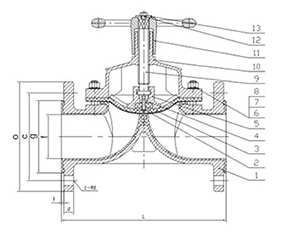Valve nominal diameter range: DN15-DN150
Applicable flange specifications: JIS 10K ASME 150LB
Maximum operating pressure: 1.0Mpa
Operating temperature range: -20° C ~ 150° C
Sealing test pressure: 1.1Mpa
Strength test pressure: 1.5Mpa
Main materials: Valve body: WCB, Lining: PFA
Coating method: epoxy resin
The Fluorine Lined Diaphragm Valve marks a significant evolution in valve technology, tailored specifically for industries where media purity and system integrity are non-negotiable. This valve type emerged as a response to the pressing need for a solution that could handle highly corrosive and hazardous media without the risk of leaks, contamination, or damage to the valve mechanism itself. The incorporation of fluorine lining, typically PTFE (Polytetrafluoroethylene), ensures that these valves can withstand aggressive chemicals that would compromise conventional valves. Their critical role is evident across a spectrum of industries, including chemical processing, acid and alkali production, smelting, rare earth extraction, and pesticide manufacturing. In these sectors, the Fluorine Lined Diaphragm Valve not only enhances operational safety and efficiency but also plays a pivotal role in maintaining product purity and environmental compliance.
The Fluorine Lined Diaphragm Valve is ingeniously designed to offer unparalleled reliability and performance in corrosive environments. At its core, the valve features a PTFE lining that extends across the internal surfaces, providing a robust barrier against corrosive agents. This lining benefits from PTFE's exceptional chemical resistance properties, ensuring the valve's longevity and reliability.
| Standard Specifications | |
|---|---|
| Valve Nominal Diameter Range | DN15-DN150 |
| Applicable Flange Standards | JIS 10K & ASME 150LB |
| Maximum Working Pressure | 1.0Mpa |
| Operating Temperature Range | -20°C ~ 150°C |
| Seal Test Pressure | 1.1Mpa |
| Strength Test Pressure | 1.5Mpa |
| Main Material | Valve Body: WCB, Lining: PFA |
| Coating Method | Epoxy Resin |
Design and Operational Mechanism: Unlike traditional valves, the Fluorine Lined Diaphragm Valve operates without stuffing boxes, utilizing a flexible diaphragm that acts both as a seal and a movable barrier to control flow. This design effectively isolates the flow medium from the valve's mechanical components, thereby eliminating common issues such as leaks, drips, and emissions. The actuation of the valve is achieved through the movement of the diaphragm, which is controlled by a handle or an actuator, depending on the valve's configuration.
Versatility in Media Compatibility: One of the standout features of the Fluorine Lined Diaphragm Valve is its compatibility with a wide array of corrosive media. The valve's PTFE lining is inert to most acids, bases, and organic solvents, making it an ideal choice for applications involving corrosive fluids.
Operational Excellence: The valve is characterized by its low operational torque and minimal friction, attributes that contribute to its ease of use and operational efficiency. These features, combined with the valve's superior sealing performance, ensure that the flow of media can be precisely controlled with minimal effort.
Extended Service Life: The robust construction and innovative design of the Fluorine Lined Diaphragm Valve contribute to its extended service life. The high elasticity of the PTFE diaphragm, coupled with the valve's resistance to corrosive wear, means that it remains operational over longer periods compared to standard valves, reducing the need for frequent replacements and maintenance.
High Purity: The fluorine lining, specifically PTFE, ensures that the media handled by the valve maintains its purity, making it indispensable in industries such as pharmaceuticals and food processing where contamination can have significant repercussions.
Low Precipitate Release: The smooth, inert surface of the PTFE lining minimizes the adhesion of particles, thus reducing precipitate release into the flow. This is crucial in applications requiring the utmost cleanliness and purity.
Resistance to Gas Permeation: PTFE's tight molecular structure offers exceptional resistance to gas permeation, an essential characteristic for preventing gas leaks and ensuring the safety of processes involving hazardous gases.
Smooth Flow Path: The design of the fluorine lined diaphragm valve ensures a smooth flow path, significantly reducing flow resistance and allowing for a larger flow capacity. This efficiency is vital in high-volume production environments.
Excellent Sealing Capabilities: The high elasticity of the PTFE diaphragm contributes to the valve's excellent sealing capabilities. This elasticity allows the diaphragm to conform closely to the valve body, ensuring a tight seal that prevents leaks and emissions, even under varying pressure conditions.
Working Pressure: The valve is rated for a working pressure of up to 1.6MPa, accommodating a broad range of industrial applications and ensuring reliable performance under pressure.
Temperature Range: Capable of operating within a temperature range of -100 to +180°C, the valve is suited for processes involving extreme temperatures, from cryogenic conditions to high heat.
Body Material Options: Available in durable materials such as carbon steel and stainless steel 304, the valve body options offer flexibility to match the chemical compatibility requirements of different media.
| CV value when opening at 90° | ||||||||
| Diameter(mm) | 25 | 40 | 50 | 80 | 100 | 150 | 200 | 300 |
| 150LB | 17 | 39 | 70 | 180 | 305 | 712 | 1011 | 2435 |
| GB/T 9113.1 PN10 connection dimensions | |||||||
| DN | L | o | c | g | b | f | z-øD |
| 15 | 125 | 95 | 65 | 46 | 12 | 3 | 4-ø14 |
| 20 | 135 | 105 | 75 | 56 | 14 | 3 | 4-ø14 |
| 25 | 145 | 115 | 85 | 65 | 14 | 3 | 4-ø14 |
| 32 | 160 | 140 | 100 | 76 | 16 | 3 | 4-ø18 |
| 40 | 180 | 150 | 110 | 84 | 16 | 4 | 4-ø18 |
| 50 | 210 | 165 | 125 | 99 | 18 | 4 | 4-ø18 |
| 65 | 250 | 185 | 145 | 118 | 18 | 4 | 4-ø18 |
| 80 | 300 | 200 | 160 | 132 | 18 | 4 | 8-ø18 |
| 100 | 350 | 220 | 180 | 156 | 20 | 4 | 8-ø18 |
| 125 | 400 | 250 | 210 | 184 | 20 | 4 | 8-ø18 |
| 150 | 460 | 285 | 240 | 211 | 22 | 4 | 8-ø22 |
| 200 | 570 | 340 | 295 | 266 | 22 | 4 | 8-ø22 |
| 250 | 680 | 395 | 350 | 319 | 24 | 4 | 12-ø22 |
| 300 | 790 | 445 | 400 | 370 | 24 | 5 | 12-ø22 |
The valve is manufactured in accordance with rigorous design standards and compliance requirements, ensuring its quality and reliability in corrosive environments. This adherence to standards guarantees the valve's performance and durability over time.
Actuators: To automate valve operation, actuators (pneumatic or electric) can be fitted, enhancing the valve's functionality in automated process control systems.
Position Indicators: For real-time monitoring of valve status, position indicators can be integrated, providing visual or electronic signals indicating whether the valve is open or closed.
Stem Extensions: For installations where the valve is located in hard-to-reach places, stem extensions are available to facilitate operation without the need for direct access to the valve body.
| Parts materials and dimensions | ||||||
|---|---|---|---|---|---|---|
| Part | Description | Material | Part | Description | Material |  |
| 1 | Valve Body | WCB+PFA | 8 | Gasket | 45 | |
| 2 | Diaphragm | PFA | 9 | Stem | 45 | |
| 3 | Rubber Gasket | NBR | 10 | Valve Cap | 45 | |
| 4 | Connecting Block | 45 | 11 | Handwheel | WCB | |
| 5 | Valve Disc | WCB | 12 | Bolt | 45 | |
| 6 | Bolt | 45 | 13 | Gasket | 45 | |
| 7 | Nut | 45 | ||||
The Fluorine Lined Diaphragm Valve is a versatile component essential in industries where corrosion resistance and media purity are critical. Its unique design and material composition make it ideal for a wide range of applications:
Chemical Industry: Utilized for the transfer of aggressive chemicals, including acids, bases, and solvents. The valve's corrosion resistance ensures safe handling of these substances, preventing contamination and ensuring worker safety.
Pharmaceutical and Biotech: Plays a crucial role in media isolation processes, where maintaining the purity of liquids is paramount. The valve's high purity and low precipitate release features are especially beneficial in sterile environments.
Water Treatment: Used in controlling the flow of various treatment chemicals. Its resistance to corrosive substances makes it suitable for chlorine and other disinfectant dosing applications.
Food and Beverage: The valve finds application in handling food-grade chemicals and ingredients, where its ability to maintain media purity and prevent contamination supports compliance with health and safety standards.
Semiconductor Manufacturing: In processes requiring the handling of etching and cleaning chemicals, the valve's exceptional chemical resistance and precise flow control capabilities are indispensable.
Answer: Consider the type of media, operating pressure, and temperature range of your application. Select a valve with a lining material compatible with the chemicals you're handling and specifications that match your system's requirements.
Answer: Ensure the valve is oriented correctly for flow direction and installed in a location that allows for easy maintenance. Consider the use of flanges or fittings compatible with the valve ends for a secure installation.
Answer: Regular inspections should include checking the diaphragm for wear or damage and ensuring that the valve operates smoothly. Follow manufacturer guidelines for replacement intervals of the diaphragm and other wearable parts.
Answer: Troubleshooting should start with verifying the installation and ensuring that the valve is not being operated beyond its specified limits. If problems persist, consult the manufacturer's support for advice or replacement parts.
Answer: To optimize performance, ensure that the valve is used within its specified parameters, including pressure, temperature, and chemical compatibility. Regular maintenance and timely replacement of the diaphragm will help maintain optimal functionality and extend the valve's service life.
Phone:+86-15716151880
Email:[email protected]
Company:BEANT
Address:No. 28, Luoshen Road, Luoshe Town, Huishan District, Wuxi City, Jiangsu Province
